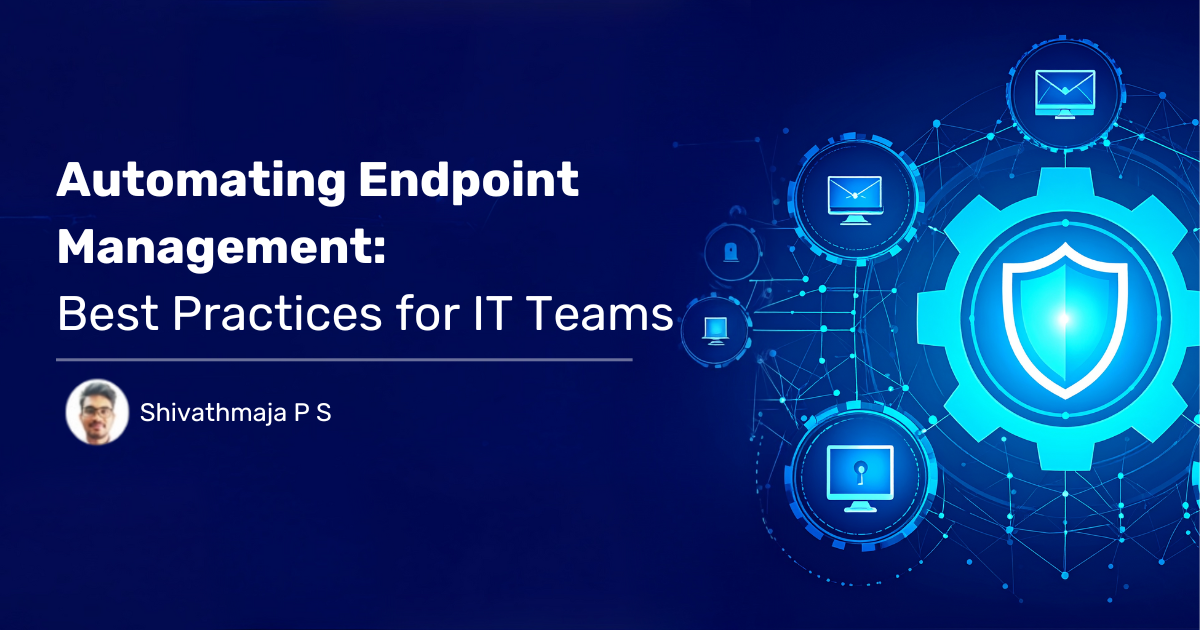Every organization in the world relies on laptops, mobile devices, servers, and IoT equipment. Each device provides business applications and but also might hold sensitive data, which can pose a potential risk if left unmanaged. Manually checking and managing these endpoints is practically impossible, and we don’t have enough manpower to keep up with the scale and complexity of modern IT environments. Automation offers IT teams a way to maintain consistent control, reduce repetitive tasks, and keep operations steady even as device counts grow.
Why Endpoint Management Matters for Reliable IT Operations
Endpoints touch every part of daily work. When a laptop or server runs outdated software or is configured incorrectly, the results can disrupt productivity and open opportunities for attackers. Key concerns include:
- Operational interruptions – A failed patch or hardware issue can halt workflows and create costly delays.
- Regulatory exposure – Standards such as HIPAA, PCI DSS, and GDPR require documented control over devices handling sensitive information. Limited visibility or missed updates can lead to compliance penalties.
- Financial loss – Recovery from a breach or extended downtime often carries significant expense.
A structured endpoint management strategy brings consistency to configurations, continuous monitoring, and rapid remediation. Without it, the organization risks downtime, compliance issues, and potential security incidents.
Endpoint Management as a Security Foundation
Cyber threats often target endpoints first. Phishing emails, malicious downloads, and unpatched vulnerabilities all provide attackers with openings. Strong endpoint management helps reduce those openings by:
- Addressing vulnerabilities quickly – Centralized oversight lets IT staff identify and patch weaknesses before they can be exploited.
- Maintaining consistent settings – Automated policies keep encryption, multi-factor authentication, and firewall rules active and uniform across devices.
- Detecting threats early – Integration with endpoint detection tools allows real-time monitoring and rapid isolation of suspicious activity.
- Protecting data – Device management supports remote wipe and secure backups, limiting data exposure if hardware is lost or stolen.
With coordinated controls in place, each device becomes far less likely to serve as an entry point for an attacker.
How Automation Streamlines the Process
Automation reduces repetitive work and enforces standards without requiring constant manual input. IT teams define rules once, and automated tools carry them out across thousands of endpoints. Key advantages include:
- Consistency across all devices – Security updates and configuration changes reach every endpoint uniformly.
- Speed of response – Urgent patches or configuration changes can be deployed to all devices within hours.
- Reduced workload – Automated workflows free IT staff to focus on higher-level initiatives such as infrastructure planning or advanced threat analysis.
Automation supports the entire endpoint lifecycle, from provisioning to decommissioning.
Best Practices for Automated Endpoint Management
Unified Oversight Through a Single Platform
Start with a central management console, such as Microsoft Intune or VMware Workspace ONE, to maintain a complete inventory of every device, including those used by remote workers. From this console, IT teams can apply policies, push software, and review compliance reports without juggling multiple tools.
Patch Management Without Delays
Automated patching systems scan continuously for missing updates, rank patches by severity, and apply them during designated maintenance windows. Responding to newly disclosed vulnerabilities the same day drastically narrows the time attackers have to exploit flaws.
Policy-Driven Configurations
Create configuration templates that specify operating system settings, encryption requirements, and firewall rules. Automated compliance checks detect when a device drifts from these standards and trigger corrective actions, such as reapplying encryption or adjusting access controls.
Integrated Security Monitoring
Pair endpoint management with security monitoring for faster response. Endpoint detection and response (EDR) tools can quarantine devices that exhibit suspicious activity and initiate scripted actions like log collection or malware removal. Integrating with a security information and event management (SIEM) system provides a complete view of potential threats.
Zero-Touch Device Provisioning
For remote or hybrid teams, zero-touch provisioning allows new devices to apply corporate images, software, and settings automatically on first boot. This approach delivers ready-to-use equipment to employees without requiring on-site IT support.
Automated Asset Lifecycle Tracking
Endpoints eventually need upgrades or retirement. Automated lifecycle management records hardware age, warranty details, and usage history. When a device reaches end-of-life, workflows can back up data, wipe drives securely, and update inventory, reducing risk and administrative effort.
Continuous Compliance Reporting
Audits often require proof of patch levels, encryption status, and configuration changes. Automated reporting provides real-time dashboards and on-demand audit trails, simplifying compliance with standards such as HIPAA or ISO 27001.
Plan for Scalability and Adaptability
Choose tools that support multiple operating systems, integrate with cloud services, and adjust to new security requirements. Scalable automation ensures that adding hundreds or thousands of devices does not increase complexity.
Final Thoughts
Effective endpoint management protects data, keeps operations steady, and supports regulatory compliance. Manual methods cannot match the scale and speed required as organizations grow and cyber threats evolve. By using centralized control, automated patching, policy-based configurations, and integrated security monitoring, IT teams gain the consistency and responsiveness they need to maintain a secure, disruption-resistant environment.


